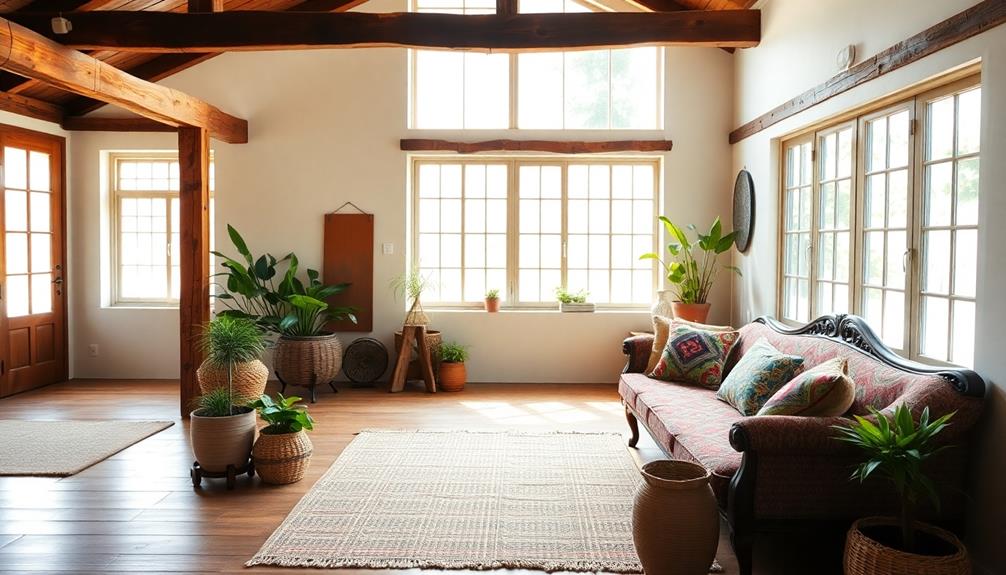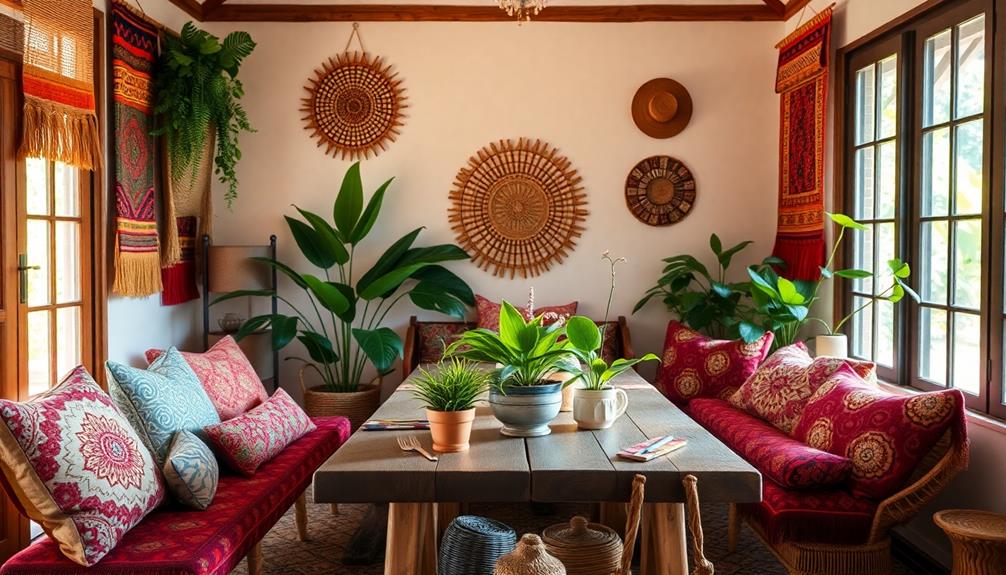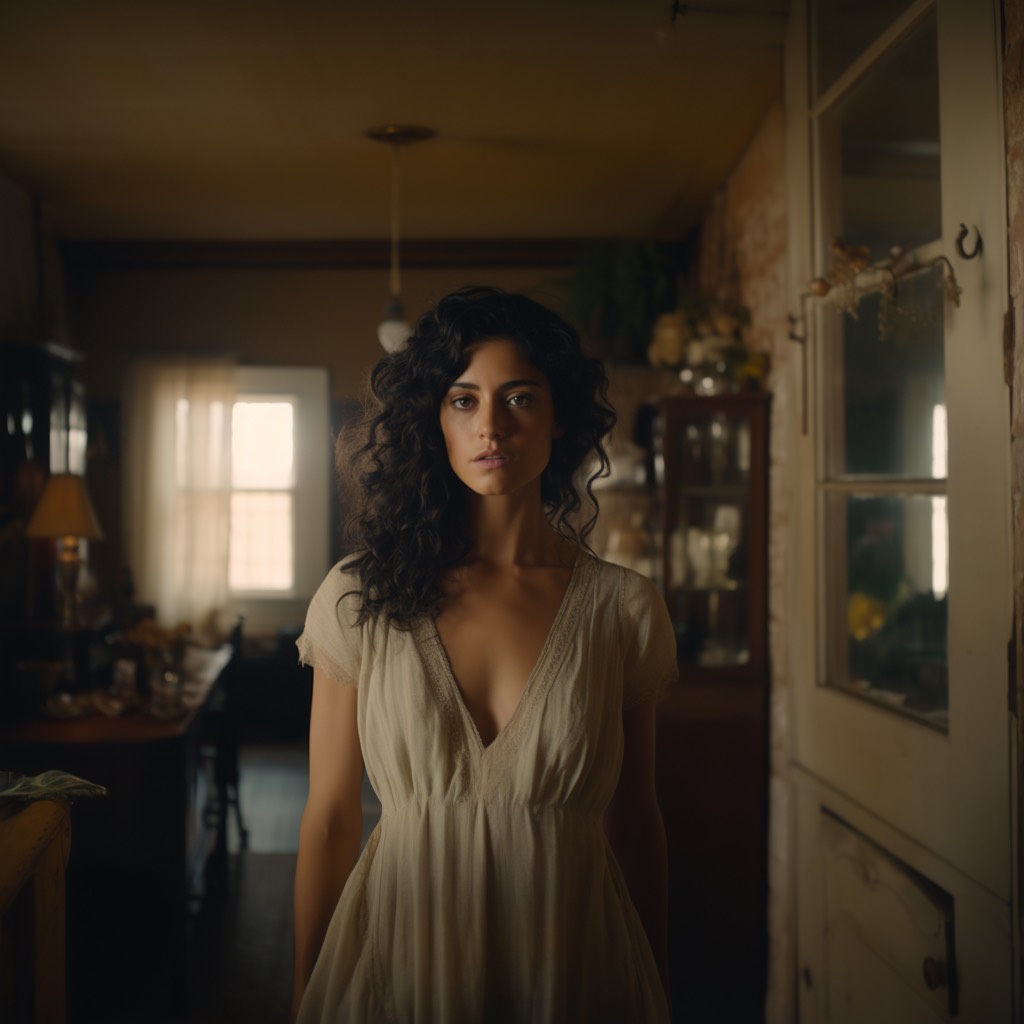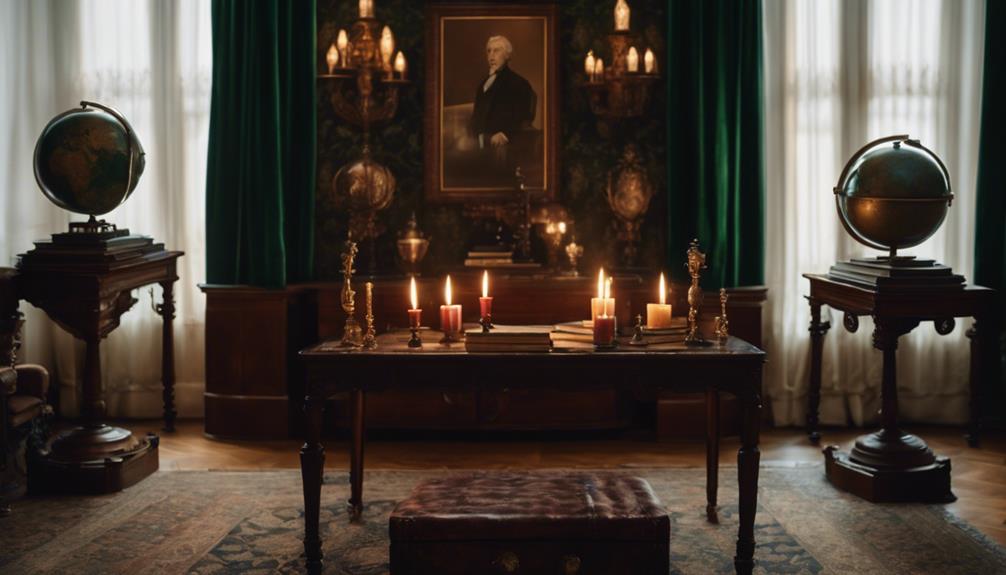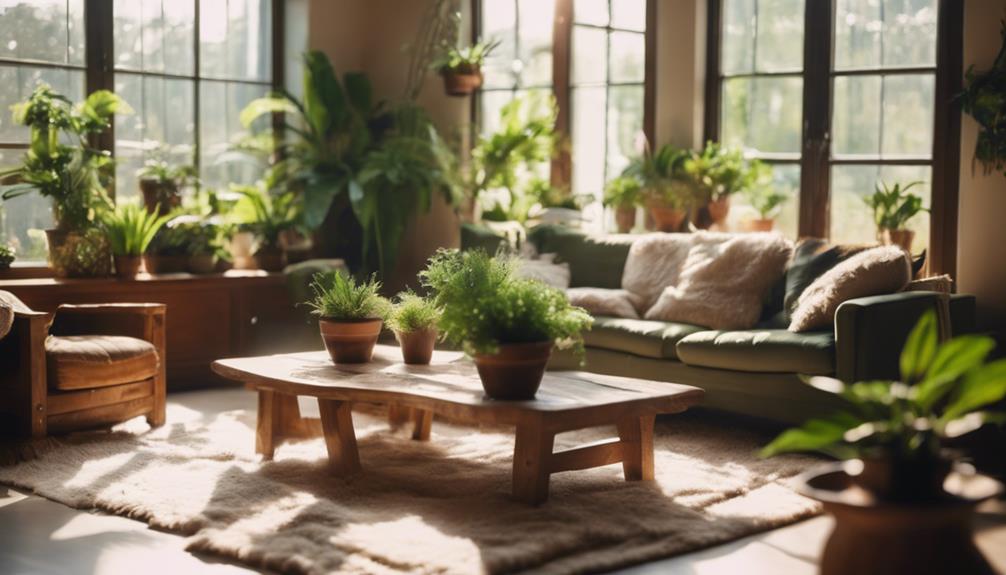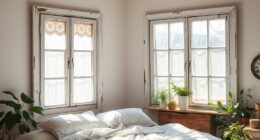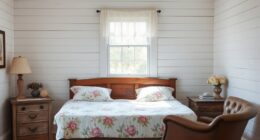To craft authentic farmhouse interiors with Indonesian textiles, embrace simplicity and warmth by incorporating unique fabrics like batik and ikat. Focus on a neutral color palette with earthy tones, allowing vibrant textiles to create striking focal points. Layer these textiles through cushions, throws, or wall hangings to enhance texture and comfort. Mix bold patterns with rustic elements for visual balance, and guarantee each piece tells a story of craftsmanship and culture. Personalize your space with handcrafted items for added charm. There's so much more to explore as you create a beautiful blend of farmhouse aesthetics and rich cultural heritage. When infusing modern farmhouse interiors with Indonesian textiles, consider contemporary furniture and clean lines to achieve a seamless integration of old and new. Embrace the juxtaposition of traditional and modern elements to create a timeless and inviting space. The incorporation of Indonesian textiles adds depth and character to the overall design, creating a space that feels both current and culturally rich.
Key Takeaways
- Incorporate vibrant Indonesian textiles like Batik and Ikat as focal points to enhance warmth and visual appeal in farmhouse interiors.
- Use a neutral color palette to balance the rich colors and intricate patterns of Indonesian textiles for a serene and inviting atmosphere.
- Layer textiles on furniture, such as cushions and throws, to create comfort and texture while embracing rustic charm.
- Personalize spaces with handmade Indonesian textiles to add unique storytelling and cultural significance to farmhouse decor.
- Maintain and care for textiles through regular cleaning and proper storage to preserve their integrity and vibrancy over time.
Understanding Farmhouse Design Principles
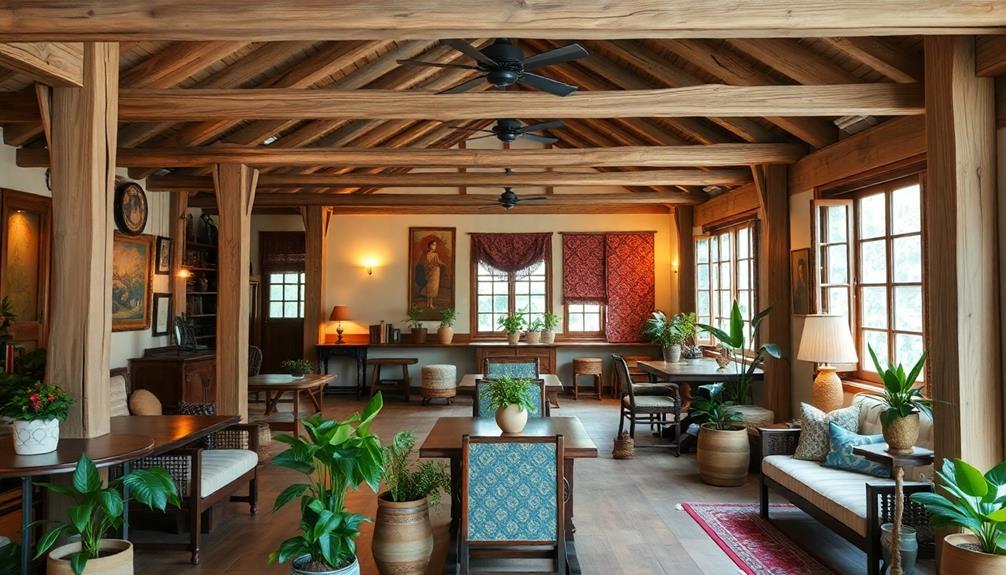
Understanding farmhouse design principles means embracing simplicity and coziness in your space. At the heart of this style, you'll find a strong connection to nature, utilizing natural materials like wood and stone to create warm and inviting environments.
These elements not only add warmth but also enhance the rustic charm that defines farmhouse interiors. Additionally, incorporating natural materials like wood and stone can also resonate with Balinese design, creating a harmonious blend of styles.
A neutral color palette is vital in this design approach. You'll often see whites, creams, and soft earth tones dominating the decor, allowing versatility and a soothing atmosphere.
This backdrop sets the stage for personal touches and unique decor items that tell your story, such as family heirlooms or handcrafted pieces.
Moreover, think about the layout of your space. Open spaces and functional arrangements are important, as they promote a sense of flow and togetherness.
You want to guarantee that movement is effortless, making your home feel welcoming and lived-in.
The Role of Indonesian Textiles

When you incorporate Indonesian textiles into your farmhouse decor, you're not just adding color; you're embracing a rich cultural heritage.
The intricate ikat patterns can serve as stunning focal points, seamlessly blending with rustic elements.
Traditional artistry found in Indonesian decor masks can further enhance your design scheme.
Mixing these unique textures and styles enhances the warmth and character of your space, creating a truly inviting atmosphere.
Cultural Significance of Textiles
Indonesian textiles, with their intricate patterns and vibrant colors, hold immense cultural significance that transcends mere decoration.
These traditional textiles, like batik and ikat, embody the rich heritage of Indonesia, often representing regional identities and stories. Incorporating these textiles into your farmhouse interiors not only adds rustic charm but also reflects the versatility of Indonesian decorative pillows, celebrating the craftsmanship and cultural narratives behind each piece.
Batik, recognized by UNESCO as an Intangible Cultural Heritage, showcases the artistry and dedication of Indonesian artisans. Similarly, the ikat weaving technique, where yarns are dyed before weaving, highlights the skill and cultural importance of this craft across various communities.
Textiles in Indonesia serve more than aesthetic purposes; they're integral to ceremonies and social status, symbolizing cultural identity during significant life events.
Ikat Patterns in Decor
Textiles play an essential role in farmhouse interiors, and ikat patterns stand out for their unique charm and cultural depth. Derived from a traditional Indonesian dyeing technique, ikat textiles feature blurred designs that add dynamic visual interest to your space.
These textiles not only enhance aesthetics but also resonate with the storytelling aspect of craftsmanship, making them a perfect fit for decor enthusiasts cultural storytelling aspect. You can use these vibrant patterns to make striking statements through upholstery or decorative pillows, enhancing the aesthetic appeal of your home while celebrating a rich textile heritage.
Pairing ikat fabrics with the neutral color palettes typical of farmhouse design allows you to create focal points that won't overwhelm your decor. Imagine vibrant ikat curtains or a table runner that draws the eye without clashing with your natural wood furniture.
The versatility of ikat means you can incorporate it in various forms, from accent chairs to wall hangings, effortlessly blending rustic charm with global influences.
Mixing Textures and Styles
While blending various textures and styles in your farmhouse interior, incorporating Indonesian textiles can truly elevate the space. These textiles, like ikat and batik, feature intricate patterns and vibrant colors that effortlessly mix old and new styles, adding character to your decor. Their bold designs stand out against the neutral palettes typical of farmhouse interiors, creating a striking visual contrast.
Understanding the cultural significance of housing in Indonesia can also inspire the way you select and use these textiles, as they often reflect rich traditions and local artistry.
Using natural materials such as cotton and silk in these textiles complements the wood and stone elements commonly found in farmhouse design. This creates a cohesive aesthetic that feels both inviting and sophisticated. You might consider using Indonesian fabrics as upholstery or throw pillows, infusing a global flair while enriching the cozy atmosphere that farmhouse decor is known for.
Layering Indonesian textiles with soft linens or textured wool throws enhances the dynamic interplay of textures, adding warmth and comfort to your living spaces. The craftsmanship and cultural significance behind these textiles further enrich the narrative of your farmhouse interior, blending rustic charm with artisanal heritage.
Choosing the Right Color Palette
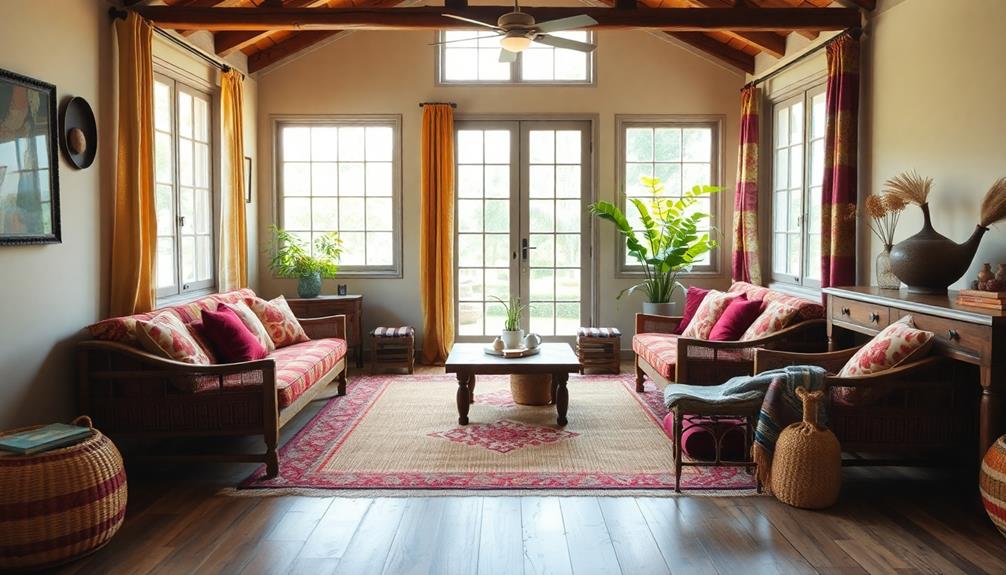
When you choose a color palette for your farmhouse interior, focus on earthy tones to create a calming foundation.
Incorporating elements of nature can enhance this serene environment, as seen in coastal color palettes that evoke a sense of tranquility.
Then, integrate vibrant accent colors to add warmth and cultural flair.
Balancing these shades with patterns and textures will guarantee your space feels cohesive and inviting.
Earthy Tone Selection
Choosing the right earthy tones can transform your farmhouse interiors into a haven of warmth and serenity. By selecting a well-defined color palette, you create a soothing backdrop that enhances the rustic charm of your space.
Incorporating elements of traditional Indonesian style home decor can further enrich your design with natural materials and textures. Here are four earthy tone choices to evaluate:
- Warm Browns: These shades evoke the essence of nature, making your interiors feel grounded and inviting.
- Soft Beiges: A versatile choice, soft beiges can brighten your space while still maintaining an earthy feel.
- Muted Greens: Reflecting the tranquility of the outdoors, muted greens bring life and freshness to your farmhouse.
- Terracotta and Earthy Reds: Inspired by Indonesian textiles, these tones add a rich depth and character to your decor.
Incorporating Indonesian textiles featuring these earthy tones can further enhance your farmhouse's warmth and style.
Don't forget to balance these shades with lighter hues, like creamy whites or soft grays, to prevent heaviness. This combination allows you to celebrate the rustic elegance of farmhouse design while creating a cozy and inviting atmosphere.
Accent Color Integration
Integrating accent colors into your farmhouse interiors can breathe new life into your design, creating a vibrant and inviting atmosphere. Start by selecting earthy tones like brown, beige, and green as your base. These colors provide a serene backdrop that beautifully complements the rustic charm of farmhouse decor. Once you have your foundation, consider incorporating bold accent colors from Indonesian textiles, such as red and turquoise, to add energy and visual interest.
To help you choose the right palette, here's a table to guide your accent color integration:
| Earthy Tones | Accent Colors | Suggested Textiles |
|---|---|---|
| Brown | Turquoise | Batik throws |
| Beige | Red | Ikat cushions |
| Olive Green | Mustard Yellow | Batik table runners |
| Tan | Coral | Ikat wall hangings |
| Cream | Navy Blue | Batik pillow covers |
Balancing Patterns and Textures
Balancing patterns and textures in your farmhouse interiors is essential for achieving a cohesive and inviting space. To create this balance, consider the following tips:
1. Opt for a Neutral Color Palette: Use neutral shades like whites, creams, and soft grays as a serene backdrop that enhances the vibrant patterns of Indonesian textiles. This approach mirrors the design ethos of Bali's interior consultants, who often emphasize creating tranquil environments.
2. Incorporate Earthy Tones: Choose earthy tones, such as browns and beiges, to complement the rich colors of your textiles, creating a cohesive aesthetic that feels warm and inviting.
These tones echo the sustainable craftsmanship found in Balinese furniture, adding a touch of authenticity to your space.
3. Mix Scale of Patterns: Use large-scale ikat designs as statement pieces against neutral backgrounds. Smaller patterns can be introduced through accents like cushions or throws to avoid overwhelming the space.
4. Emphasize Natural Fibers: Incorporate various textures, such as wood and natural fibers, to enhance the rustic charm of your farmhouse style while allowing your textiles to shine as focal points.
Incorporating Traditional Patterns

Incorporating traditional patterns into your farmhouse interior adds depth and character, transforming the space into a cozy retreat. Indonesian textiles, like ikat and batik, are perfect for this purpose, as they often feature intricate designs and vibrant colors that introduce cultural richness.
These textiles can also include elements like unique artistic expressions that further enhance the overall aesthetic. Use these textiles as accent pieces—throw pillows, wall hangings, or table runners—to create visual interest while maintaining that warm atmosphere.
Mixing different scales of patterns is key. Pair larger ikat designs with smaller floral or check patterns that are common in farmhouse decor. This balance keeps your aesthetic cohesive and inviting.
Opt for earthy, neutral color palettes found in traditional Indonesian textiles to complement the rustic charm of your farmhouse. These natural tones help create spaces that feel harmonious and well-designed.
Don't shy away from showcasing the craftsmanship of Indonesian textiles. Display them prominently in framed wall art or as decorative table runners, enhancing the authenticity of your interior.
Layering Textiles for Texture
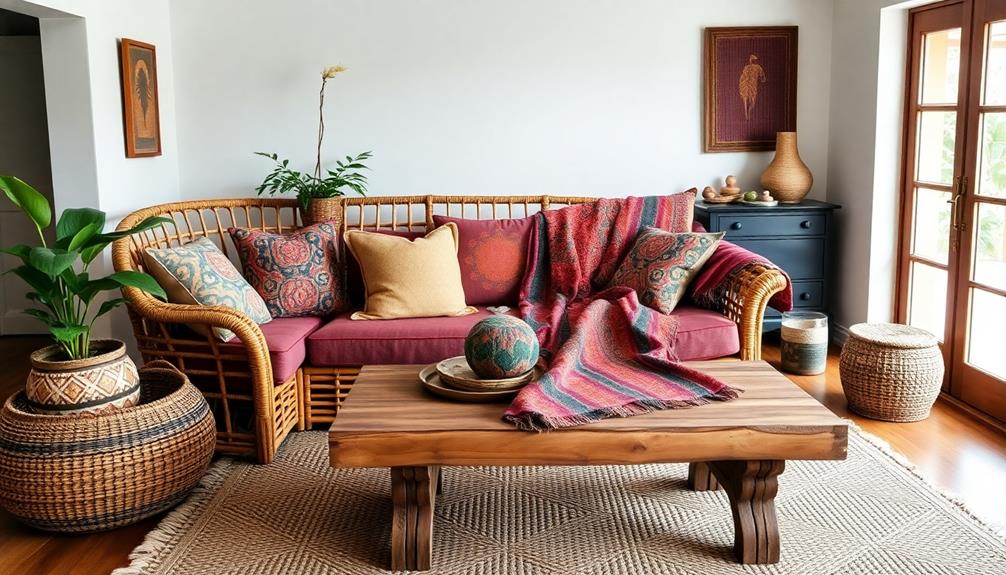
Layering textiles is a simple yet effective way to add depth and warmth to your farmhouse interior. By mixing different textures and patterns, you can create a cozy atmosphere that feels both inviting and stylish. Traditional Indonesian textiles, known for their rich cultural heritage, can beautifully complement modern design elements.
Here are some tips to help you master the art of layering textiles:
- Combine bold and subtle: Use vibrant Indonesian textiles like batik and ikat alongside solid colors. This creates a balanced aesthetic, allowing the unique designs to shine without overwhelming the space.
- Incorporate various textures: Layer soft blankets over woven rugs or mix patterned pillows on a simple sofa. This adds visual interest and depth, making your space feel more dynamic.
- Utilize natural materials: Opt for textiles made from linen, cotton, and wool. These materials enhance the tactile experience and contribute to a warm, rustic vibe while reflecting the use of local materials characteristic of traditional Indonesian housing.
- Focus on functional pieces: Choose cushions, throws, and curtains that not only look good but also provide comfort and style, integrating traditional Indonesian textiles into your design.
Balancing Modern and Rustic Elements
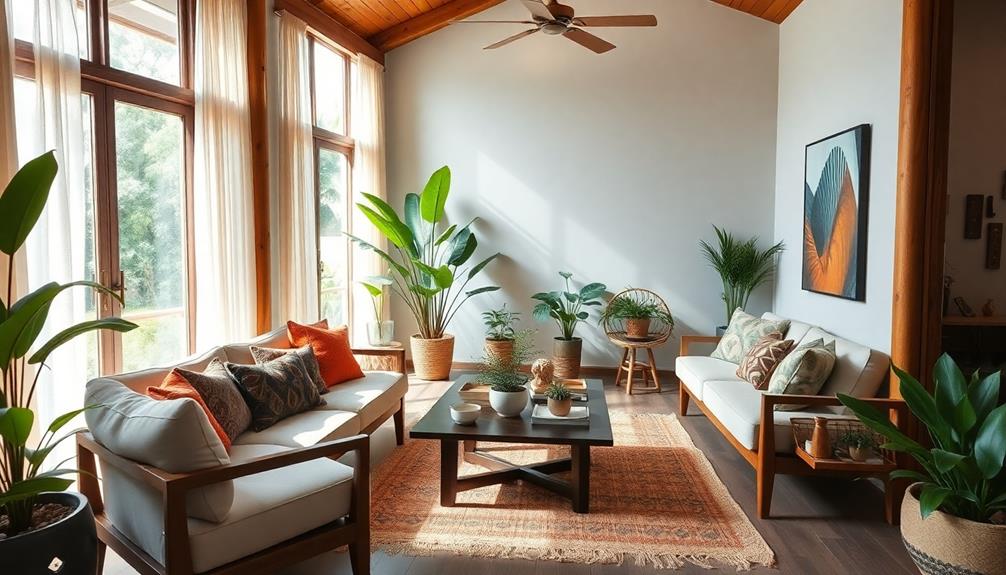
Creating a harmonious blend of modern and rustic elements in your farmhouse interior can transform the space into a warm and inviting sanctuary. Start by incorporating Indonesian textiles like ikat and batik, which introduce vibrant patterns and cultural significance to your decor. These textiles can serve as focal points, adding character without overwhelming the rustic charm of your home. To balance the traditional feel of the textiles, consider incorporating modern farmhouse decor ideas such as sleek metal light fixtures, clean-lined furniture, and minimalist artwork. These elements will add a touch of contemporary style while still complementing the rustic aesthetic of the farmhouse. By combining modern and rustic elements, you can create a space that feels both current and timeless, inviting and visually interesting. In addition, mindful furniture placement can enhance the flow of energy within your home, drawing inspiration from **feng shui farmhouse furniture** principles. Opt for pieces that are both functional and aesthetically soothing, such as weathered wooden tables paired with simple, modern chairs that effortlessly bridge the gap between the old and the new. This thoughtful fusion of styles will ensure your space feels balanced, comfortable, and full of positive energy.
Use a neutral color palette, focusing on whites and soft earth tones, to create a serene backdrop. This allows the bold colors of the textiles to shine while maintaining balance.
Combine traditional wooden furniture with contemporary pieces to enhance functionality while respecting rustic aesthetics.
Layer the Indonesian textiles with farmhouse staples like linen or cotton to introduce texture and depth, enriching your overall design.
Emphasize open spaces and natural light, allowing the unique patterns and colors of the textiles to enhance the inviting atmosphere characteristic of modern farmhouse interiors.
This thoughtful integration of modern and rustic elements will create a cohesive, stylish environment that feels both timeless and contemporary, inviting you to enjoy your sanctuary every day.
Creating Cozy Spaces

When you walk into a farmhouse interior, the key to making it feel cozy lies in the thoughtful selection of textiles and materials. To create a warm and inviting atmosphere, focus on integrating traditional Indonesian textiles alongside natural elements.
Here are four essential tips to help you achieve that cozy vibe:
- Use Vibrant Textiles: Incorporate Indonesian batik and ikat fabrics to add rich colors and patterns that enhance the room's warmth.
- Choose Natural Materials: Combine wood, stone, and rattan with your textiles to reflect the rustic charm of farmhouse design.
- Layer Textures: Mix soft Indonesian fabrics with durable elements like burlap or linen to create a tactile experience that invites comfort.
- Personalize with Handmade Items: Integrate woven baskets or cushions to add a unique touch that tells a story and makes the space feel more intimate.
Additionally, emphasize natural light by arranging furniture around these textile accents. This encourages relaxation and social interaction, further enhancing the cozy ambiance of your farmhouse interior.
Highlighting Cultural Significance

Incorporating Indonesian textiles into your farmhouse interior not only elevates the aesthetic but also celebrates the rich cultural heritage behind them. Textiles like ikat and batik carry deep cultural significance, reflecting the artistic traditions of various Indonesian communities.
The ikat technique, with its intricate dyeing processes, symbolizes the craftsmanship and storytelling of its creators, often depicting life and nature. Batik, on the other hand, showcases a unique wax-resist dyeing method that serves not just as a textile art form but also as a means of cultural expression, often featured in ceremonial garments.
By integrating these fabrics, you're not just adding decor; you're infusing your space with authenticity and a narrative that echoes the history and traditions of Indonesia.
These vibrant textiles enhance farmhouse interiors, bringing in colors and patterns that resonate with rustic charm while promoting global cultural appreciation. Each piece tells a story, enriching the ambiance of your home.
Frequently Asked Questions
What Is an Indonesian Style of Textile?
An Indonesian style of textile you might love is ikat. It's created by dyeing yarns before weaving, resulting in unique patterns. Batik, known for its wax-resist dyeing, offers vibrant colors and rich textures, too.
What Is the Fabric Using Indonesian Dyeing Technique?
The fabric using the Indonesian dyeing technique is called ikat. It features intricate patterns created by binding and dyeing yarns before weaving, showcasing unique designs that reflect the artisan's skill and cultural heritage.
How Textiles Are Used in Interiors?
Textiles in interiors are like a warm hug, wrapping your space in comfort. You can use them for upholstery, draperies, and decorative pillows, creating visual interest while adding personality and authenticity to your home.
Conclusion
As you weave Indonesian textiles into your farmhouse interiors, you're not just decorating; you're telling a story that bridges cultures and generations. Each piece you choose adds depth, creating a cozy sanctuary that reflects both your personal style and the rich heritage of its origins. Coincidentally, as you embrace these vibrant patterns and textures, you might find that your home transforms into a warm gathering place, where every corner invites connection and conversation.

